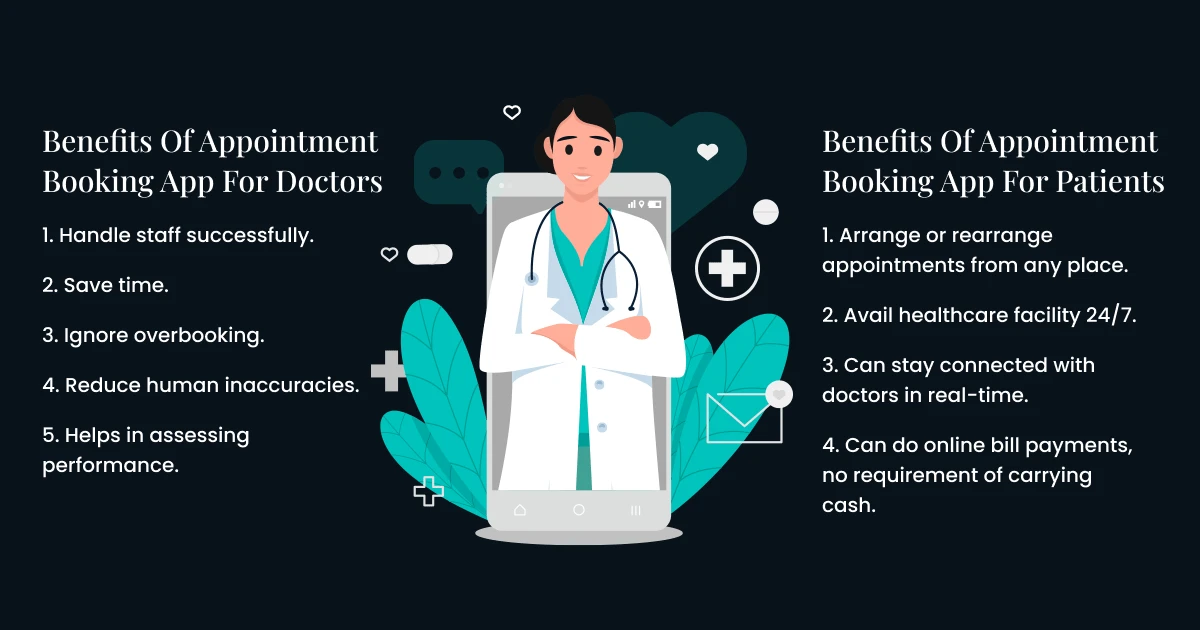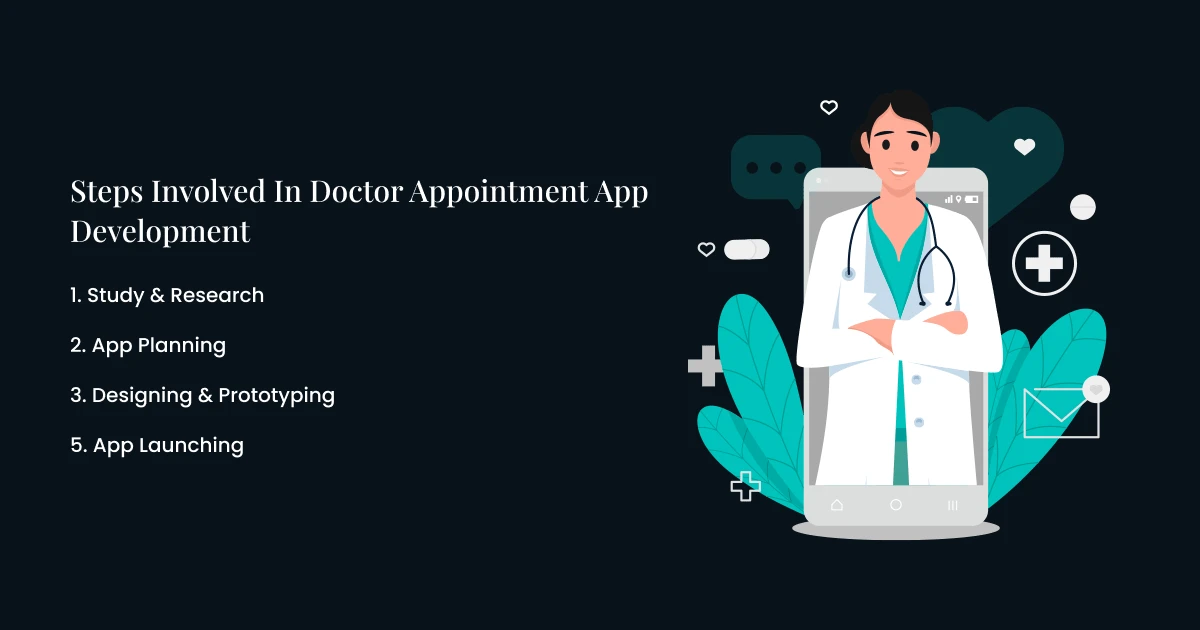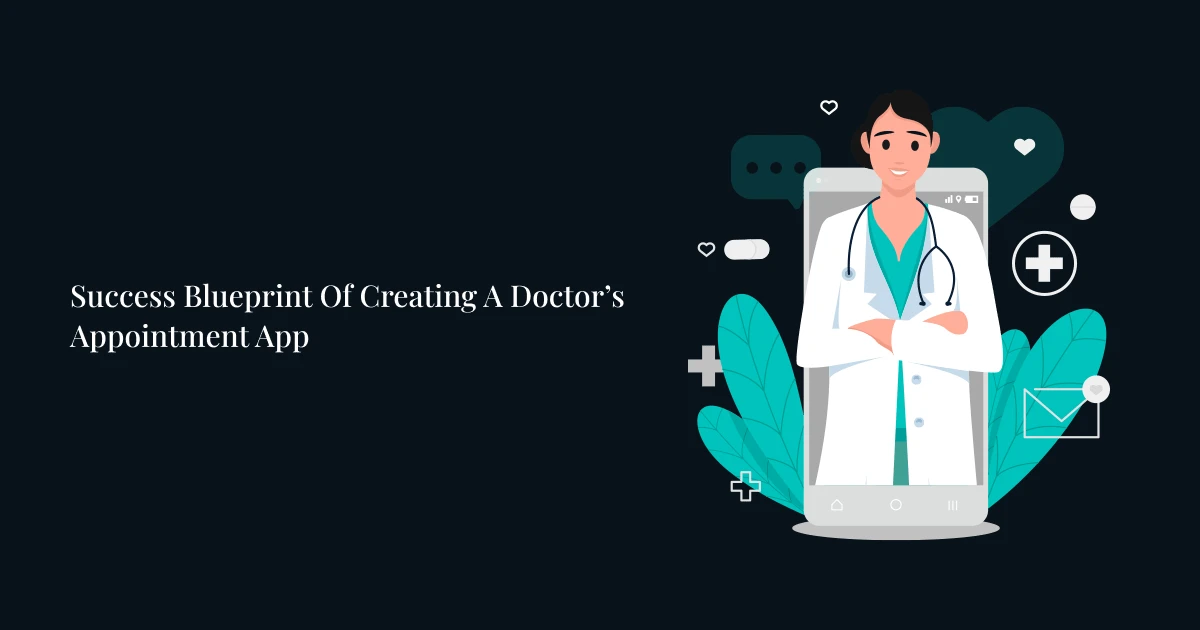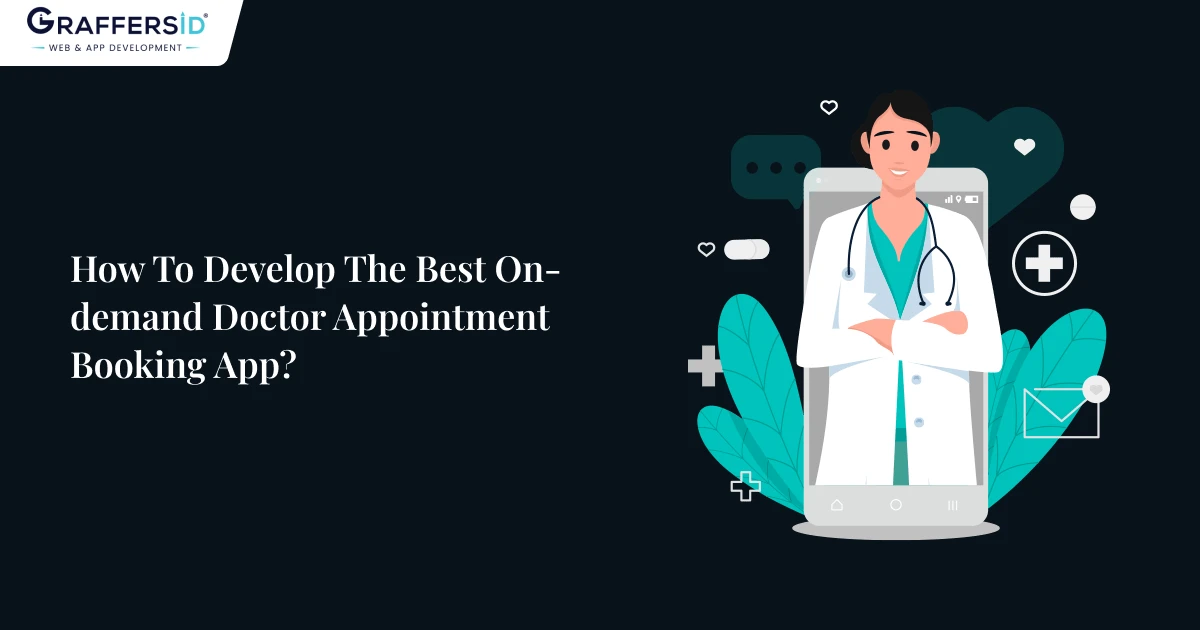Do you face any difficulties in managing patient appointments at your clinic? Do your employees take much time to schedule appointments and rationalize clinical operations? In that condition, creating a doctor appointment booking app is an ideal method to take care of your clinical appointments without running after manual records. Before developing an On-demand app, you need to understand the scope of On-demand service apps and their market trends.
In this techno-oriented world, individuals with diverse psychologies will choose to schedule their appointment before going to the place whether it is for a doctor, bar, or, salon, to save money and time. All credit goes to the breakthrough technologies and ingenious doctor appointment booking app development that have made it feasible and ended all this disturbance linked to the previously tired conventional healthcare methods.
Why Have The Best Appointment Booking App For Doctors?
Nowadays, there is a rapid increase in the number of smartphone users. There is a mobile app for day-to-day activities from ordering groceries to booking a cab, from depositing money to the bank to booking tables at your fav. Restaurant.
People are using their smartphones to plan their doctor’s appointments, medication impromptu, and different factors with their health and wellness. As they don’t want a long queue waiting for their booking number.
In this way, more people will select the healthcare service provider that gives digital prospects such as e-prescriptions, digital communication, distant tracking, and online appointments.
To fulfill people’s requirements, doctors are developing mobile apps for creating an online presence. For that, they are Hiring Vetted Healthtech Software Developers.
Approx. 43% of patients choose to book health appointments online, and 57% of people search online for a doctor or healthcare provider, according to a recent study. Additionally, 60 percent of healthcare experts and 72 percent of patients state that a digital appointment booking platform supports patients to schedule their appointments.
As a result, the online doctor appointment app plays a significant role in selecting medical services. It works like when you have a choice to book a doctor’s consultation online, you know that you are going to get the best of medical care.
Both doctors and patients wish to feel as if they are availing of all the technological changes and saving their precious time.
These are both signals of usefulness for such a choice of arranging an online doctor’s appointment. It shouldn’t be absurd to suppose that all of these figures will continuously grow in the future, seeing the acclaim of this feature in the times post-COVID.
Benefits of On-demand Doctor Appointment Booking App

Here are the benefits of the On-demand Doctor Appointment Booking App:
1. Benefits of Appointment Booking App For Patients
With an appointment application, patients do not need to call your office or wait for an appointment. Within only a few clicks, they can manage to see their needed time with the doctor. It’s highly beneficial in saving time for patients.
- Arrange or rearrange appointments from any place.
- Avail healthcare facility 24/7.
- Can stay connected with doctors in real time.
- Can do online bill payments, no requirement of carrying cash.
2. Benefits Of Appointment Booking App For Doctors
A mobile app automated the scheduled booking measures, which your employees might have difficulty dealing with manually (e.g., feeding patients’ very own understatements, setting up doctors’ time allocations, handling regulatory work, and more).
Together with these settlements, an application additionally assists in improving clinic-patient interaction.
- Handle staff successfully.
- Save time.
- Ignore overbooking.
- Reduce human inaccuracies.
- Helps in assessing performance.
Steps Involved In Doctor Appointment App Development

In general, mobile application development companies pursue the below steps to ensure feature-attributed, expansible, and powerful online doctor appointment apps:
1. Study & Research
In this step of the doctor appointment app development, the company searches for the market need for your doctor booking application, taking into account the patient’s or user’s requirements.
These points are included in this step:
- Evaluating the competitor’s application
- Finding out their benefits and drawbacks
- Integrate all of this with the user’s demands
2. App Planning
This step will determine which feature you wish to insert into your application and which technology you need to choose. This also includes considerations via encryption technologies and different technical securities for your mobile app.
As a doctor appointment app involves patients’ data, we also require thinking from the safety point of view.
3. Designing & Prototyping
In the designing and prototyping step, you have to:
- Select patterns, colors, and different visuals in the apps.
- Develop a User Interface.
- Build a simple-to-navigate appointment booking application system.
- Design and development of the clickable elements.
4. App Launching
Once the final change is done, your appointment app is now all set for its launch. But the task of a mobile app development company like us is not finished yet.
Managing your application is also uniformly significant. We at GraffersID, a top web and app development company assure that you as a healthcare provider don’t wish to spoil the patient’s experience with technical setbacks.
Together with that, daily updates and the inclusion of the latest features are essential to keep your doctor appointment booking application apart from competitors.
Want to Build An App? Book A Free Consultation With GraffersID
Key Features Of A Doctor Appointment App That You Must Have
After going through all the benefits and steps to create a doctor’s mobile app, you have come to the conclusion that now is the time to develop it, then there are essential key points you have to bear in mind.
Any medical app is required to have key health features that resolve the users’ major issues to be outstanding. In the same way, a doctor appointment app must also have some particular built-in features to fulfill the users’ needs. Let us find out what they are:
1. Doctor Appointment Booking Both Offline and online
A doctor consultation or booking app must be featured as its basic online and offline booking functionalities are innate and work properly the initial time.
There should be appointment status attributes and a completely working calendar.
2. An Admin Panel For The App
A digital medical appointment system depending on PHP language should involve an administrator panel to manage doctor and patient profiles.
If there is a need to make any modifications to anybody’s profile on the network, the system should also contain an alert section.
3. Doctor’s Profile
A doctor section that is respectively for profile making and review should be available. There is a need for accessible data like doctors’ specialization, their place, their images, reviews of patients, and what are their charges for booking an appointment according to different providers.
It will be best to keep real-time data for doctors and reports on their medical practice status. The doctor must also use this to keep up some marketing items if that is something they are looking to offer.
4. Patients’ Profiles
In the patient profiles, they need to add personal details so that doctors can update themselves with a case history if they are going to examine the patient initially. Data uploading and searching facilities would surely come in handy.
5. Listing Option With Search & Filters
For your app to be successful it is necessary to have complete doctor listings, search, and filter functionalities. You can personalize your search and modify the possibilities in a few seconds if you need to look for a medical expert.
6. Map API Integration
Map APIs can be simply added to the app to let patients get to the hospital for doctor visits without any problem. Users can also go through it when selecting the doctor because the location is also a matter of concern for patients.
7. Reminders & Alerts Features
Your appointment booking app must also have completely working appointment e-mail, mobile, or app alerts and push messages, therefore, no appointment would ever get missed.
8. Online Video Consultation Feature
One of the most important things to remember in this is as time passes by, a growing number of patients will need the capability of consulting with their doctor without the need to go into the hospital or clinic.
You will need an HD video function, audio, and chat facility in your app platform together with online booking.
9. Digital Prescriptions Feature
The doctor appointment scheduler needs to have a method for a doctor to lay down a required medicine inclusive of receipts straight in the app.
After that, the patient would be capable of ordering the prescribed medicines from your regional pharmacy or whatever they go for.
10. Symptoms And Disease Identification
You will be aware of the prevalence of Artificial Intelligence-based assistants, which can generate a diagnosis depending on the user’s disorders or symptoms.
Your doctor’s appointment app must have a symptoms checker feature to identify what expert consultation the patient ought to have.
11. Online Billing And Payment Gateway
There is a prerequisite of a handy billing feature for a doctor to create a bill and a safe payment gateway for the patient to reimburse for their booked consultations directly via the app. It also needs to add a card scanning facility.
12. Cost Calculation And Health Monitoring
A doctor appointment management system should possess a cost calculator, thus, patients will find out exactly what they are being charged all the time.
A health checker is also a feature that more people are preferring in today’s time. Even though they are in the best position in their health, they would like to track their essential organ functionality and keep a record of how many steps they are walking during the whole day.
13. A Drug Implication Tool & Safety Consent Data
A drug implication tool is useful to include in any healthcare appointment management app. A patient should know what negative effects the drugs can impose that are being given to them.
Safety consent data is also effective to have. In that way, a patient can know that they are employing the app abiding fully with PHI, HIPAA, GDPR, and European health regulations and ordinances.
Success Blueprint For Creating A Doctor’s Appointment App

Despite knowing all, something is lacking that enacts you to the progress of your scheduling app. Accordingly, here we share with you the successful blueprint for building the doctor appointment scheduling app:
- During the development of the best doctor appointment app, one of the greatest challenges is to keep up the user base! By giving discounts, rewards, promos, loyalty points, and different benefits, you can keep your patients content with your app for a long time.
- Ensure you concentrate on developing a reliable network of doctors and checking their identity. You can put up a license, relevant certificates, and various important docs of the doctor.
- To ascertain that your application runs well and increases income for your clinic or hospital, it is significant to choose the finest income model for your doctor appointment scheduling mobile app. Hence, it is indispensable to cautiously choose your app monetizing model to nail down long-term advantages to your profession.
Why should I develop a doctor appointment booking app in 2023?
Developing a doctor appointment booking app in 2023 can offer several advantages and opportunities due to the evolving healthcare landscape and technological advancements. Here are some reasons why it could be a valuable endeavor:
Convenience:
In today’s fast-paced world, people value convenience. A doctor appointment booking app can make it easy for patients to schedule appointments at their preferred times, reducing the need for lengthy phone calls and allowing them to manage their healthcare on their terms.
Time Efficiency:
Such an app can streamline the appointment scheduling process for both patients and medical staff. Patients can quickly browse available slots and select suitable times, while healthcare providers can optimize their scheduling.
Reduced No-Shows:
Implementing features like appointment reminders and notifications can help reduce the number of no-shows. This benefits both patients, who are less likely to miss appointments, and doctors, who can better manage their schedules.
Access to Information:
A well-designed app can provide patients with essential information about doctors, their specialties, credentials, and patient reviews. This empowers patients to make informed decisions when choosing a healthcare provider.
Telehealth Integration:
With the rise of telehealth and virtual consultations, your app could facilitate video appointments or remote consultations. This would be especially relevant in a post-pandemic world, as people have become more accustomed to virtual healthcare interactions.
Healthcare Personalization:
Advanced algorithms and AI-driven features can help personalize the healthcare experience. The app could recommend suitable doctors based on the patient’s medical history, preferences, and needs.
Efficient Resource Utilization:
For healthcare providers, an app can optimize resource utilization by evenly distributing appointments, reducing waiting times, and enabling efficient use of medical staff and facilities.
Market Demand:
The demand for digital healthcare solutions continues to grow. As people become more tech-savvy, they expect user-friendly platforms to manage their health-related activities. A well-developed app can tap into this expanding market.
Partnerships with Healthcare Institutions:
By collaborating with hospitals, clinics, and individual practitioners, your app can become a preferred platform for appointment bookings. Such partnerships can provide credibility and a wider user base.
Data Insights:
The app’s usage can generate valuable data insights about healthcare trends, patient preferences, and more. This data can be anonymized and used to improve the overall healthcare system or to provide additional services.
Monetization Opportunities:
You can monetize the app through various models, such as subscription fees for premium features, partnerships with healthcare providers, or even targeted advertising for health-related products and services.
Long-Term Viability:
The healthcare industry is a fundamental and evergreen sector. Developing a doctor appointment booking app positions you at the intersection of technology and healthcare, offering long-term viability and growth potential.
How to Create a Successful Telemedicine App
Telemedicine has become increasingly popular over the past few years, especially in the wake of the COVID-19 pandemic. The ability to receive medical advice and treatment remotely has made healthcare more accessible and convenient for patients around the world. Telemedicine apps are the key to enabling these services, and as a result, the demand for such apps has increased significantly.
If you’re a healthcare provider looking to create a telemedicine app, you’re in the right place. In this blog, we will guide you through the process of creating a telemedicine app, from research and analysis to launch and maintenance. We will discuss the key features of a telemedicine app, the technology required, and the importance of security and privacy. Additionally, we will cover the essential steps to testing, launching, and marketing your app successfully.
By the end of this blog, you will have a clear understanding of how to create a telemedicine app that is functional, user-friendly, and secure. Whether you’re a healthcare provider, a tech entrepreneur, or a software developer, this guide will provide you with valuable insights into the world of telemedicine app development.
Steps to Follow for Creating a Telemedicine App

Research and Analysis
Research and analysis are crucial steps in creating a successful telemedicine app. Before you begin the development process, you must understand your target audience, market demand, and competition. In this section, we’ll discuss the essential aspects of research and analysis for creating a telemedicine app.
- Analyzing the Market Demand
First and foremost, you need to analyze the market demand for telemedicine apps. This step involves understanding the current and future trends in the healthcare industry. You can conduct market research to gain insights into the market size, growth rate, and potential revenue. Identify the target audience and their needs to create a solution that meets their expectations. - Understanding the Competition
To stand out from the crowd, you need to differentiate your app from the competition. Analyze the competition to identify their strengths and weaknesses. Look at their pricing, features, user experience, and marketing strategies. Identify what they are doing well and what they are missing. Use this information to develop your unique selling proposition (USP). - Identifying the Key Features
A telemedicine app must have several essential features, such as appointment booking, virtual consultations, secure messaging, and e-prescriptions. However, there are many other features that you could consider adding to your app, such as patient records, appointment reminders, and medication management. Identify the key features that are essential to your target audience and prioritize them in the development process.
Design and Development
Design and development are critical steps in creating a telemedicine app that is functional, user-friendly, and secure. In this section, we’ll discuss the essential aspects of design and development for creating a telemedicine app.
- Choosing the Right Platform and Technology
Choosing the right platform and technology is crucial for the development of a telemedicine app. Consider the user base and the target audience when deciding between iOS, Android, or both platforms. Additionally, consider the programming language and framework to use in app development. It is essential to choose a technology that allows you to create a scalable and secure application. - Creating Wireframes and Prototypes
Creating wireframes and prototypes is an essential step in the design process. Wireframes are simple, visual representations of the app’s structure, while prototypes are functional models of the app. These models will help you understand the user interface (UI) and user experience (UX) of your app. By creating these models, you can identify any usability issues early in the development process and make necessary changes. - Developing App Features and Functionalities
Developing app features and functionalities is a critical step in creating a telemedicine app. It involves creating the front-end and back-end of the application. Front-end development is about creating the UI and UX of the app, while back-end development is about creating the app’s functionality and connecting it to the database. It’s essential to develop a robust and scalable backend that can handle a large number of users. - Integrating Security and Privacy Measures
Integrating security and privacy measures is a critical step in developing a telemedicine app. You must ensure that the app is secure and that patient data is protected from unauthorized access. Consider using encryption, secure login, and two-factor authentication to secure patient data. It’s also essential to comply with relevant regulations such as HIPAA, GDPR, and CCPA.
In conclusion, design and development are critical for creating a telemedicine app that is functional, user-friendly, and secure. By choosing the right platform and technology, creating wireframes and prototypes, developing app features and functionalities, and integrating security and privacy measures, you can create a successful telemedicine app that meets the needs of your patients and healthcare providers.
Testing and Quality Assurance
Testing and quality assurance are essential steps in creating a telemedicine app that is free of bugs and errors. In this section, we’ll discuss the essential aspects of testing and quality assurance for creating a telemedicine app.
- Unit Testing
Unit testing involves testing each module of the app individually to ensure that it functions correctly. This step is critical for identifying bugs and errors in the app before moving on to the integration testing stage. Unit testing ensures that each module of the app functions as expected and is free from defects. - Integration Testing
Integration testing involves testing the app as a whole to ensure that all the modules work together seamlessly. This step is critical for identifying any compatibility issues between the different modules of the app. Integration testing ensures that the app functions as expected and is free from defects. - User Acceptance Testing
User acceptance testing involves testing the app with real users to ensure that it meets their expectations. This step is critical for identifying any usability issues in the app and ensuring that the app is user-friendly. User acceptance testing ensures that the app meets the needs of your patients and healthcare providers. - Performance Testing
Performance testing involves testing the app’s performance under different conditions, such as high traffic or low internet connectivity. This step is critical for identifying any performance issues in the app and ensuring that it is responsive and reliable. Performance testing ensures that the app can handle a large number of users and is free from performance issues.
In conclusion, testing and quality assurance are critical for creating a telemedicine app that is free from bugs and errors. By conducting unit testing, integration testing, user acceptance testing, and performance testing, you can identify any issues in the app and ensure that it meets the needs of your patients and healthcare providers.
Launch and Marketing
After completing the design, development, and testing of your telemedicine app, the next step is to launch it in the market. Launching and marketing your app effectively is crucial for reaching your target audience and driving user adoption. In this section, we’ll discuss the essential aspects of launching and marketing your telemedicine app.
- App Store Optimization (ASO)
App store optimization is the process of optimizing your app’s visibility in the app store. It involves optimizing your app’s title, description, keywords, and screenshots to make it more visible to potential users. By optimizing your app’s listing, you can increase its visibility and attract more users. - Social Media Marketing
Social media marketing is an effective way to reach a wider audience and promote your telemedicine app. By creating social media accounts for your app and regularly posting updates and engaging with your audience, you can build a loyal following and drive user adoption. You can also consider running social media ads to reach a wider audience. - Influencer Marketing
Influencer marketing involves partnering with influencers in your industry to promote your telemedicine app. By working with influencers who have a large following in the healthcare industry, you can reach a wider audience and build trust with potential users. Influencer marketing can be an effective way to drive user adoption and increase brand awareness. - Paid Advertising
Paid advertising involves running ads on various platforms such as search engines, social media, and mobile apps. By running targeted ads, you can reach your target audience and drive user adoption. Paid advertising can be an effective way to increase brand awareness and reach a wider audience. - Public Relations
Public relations involves building relationships with journalists, bloggers, and other media outlets to promote your telemedicine app. By pitching your app to these outlets and getting media coverage, you can increase brand awareness and drive user adoption. Public relations can be an effective way to build credibility and establish your app as a leader in the telemedicine industry.
In conclusion, launching and marketing your telemedicine app effectively is crucial for reaching your target audience and driving user adoption. By optimizing your app store listing, engaging in social media marketing, partnering with influencers, running paid advertising, and building relationships with media outlets, you can increase brand awareness and drive user adoption for your app.
Maintenance and Improvement
Maintenance and improvement are essential aspects of running a successful telemedicine app. Once you have launched your app and attracted users, you need to maintain and improve it to ensure it remains relevant and competitive. In this section, we’ll discuss the essential aspects of maintaining and improving your telemedicine app.
- Bug Fixes and Updates
Regularly updating your app with bug fixes and updates is critical for maintaining its functionality and keeping users satisfied. By fixing bugs and addressing user feedback, you can improve your app’s performance and ensure it remains relevant. - Security and Privacy
Security and privacy are critical considerations for telemedicine apps, as they involve handling sensitive patient information. Regularly updating your app’s security features and ensuring that it complies with data protection regulations is essential for maintaining user trust and keeping their data safe. - User Feedback and Improvement
Collecting user feedback and implementing improvements based on their suggestions is an effective way to keep your app relevant and competitive. By regularly soliciting user feedback and addressing their concerns, you can improve your app’s functionality and user experience. - New Features and Functionality
Introducing new features and functionality to your telemedicine app is essential for keeping users engaged and attracting new ones. By regularly adding new features and improving existing ones, you can stay ahead of the competition and offer a better user experience. - Performance Optimization
Optimizing your app’s performance is critical for ensuring it remains responsive and reliable, even under high traffic. Regularly monitoring your app’s performance and optimizing it for speed and efficiency is essential for keeping users satisfied and attracting new ones.
In conclusion, maintenance and improvement are critical for running a successful telemedicine app. By regularly updating your app with bug fixes and security features, collecting user feedback, introducing new features and functionality, and optimizing its performance, you can keep your app relevant and competitive in the telemedicine industry.
Conclusion
In conclusion, creating a successful telemedicine app involves several crucial steps, from research and analysis to maintenance and improvement. By conducting thorough research, identifying user needs and pain points, and designing a user-friendly interface, you can create an app that meets the needs of both patients and healthcare providers.
The development phase involves building and testing your app, ensuring that it functions properly and provides a seamless user experience. After launching your app, effective marketing strategies such as app store optimization, social media marketing, influencer marketing, paid advertising, and public relations can help drive user adoption and increase brand awareness.
Finally, maintaining and improving your app is critical for keeping users engaged, attracting new ones, and staying ahead of the competition. Regularly updating your app with bug fixes, security features, new features, and performance optimizations is essential for keeping users satisfied and maintaining your app’s relevance in the telemedicine industry.
Overall, creating a successful telemedicine app requires careful planning, execution, and ongoing maintenance. With the right approach, a telemedicine app can improve healthcare access, increase patient engagement, and streamline healthcare delivery, ultimately making a positive impact on people’s lives.
Are you looking to create a successful telemedicine app that can revolutionize the healthcare industry? Look no further than GraffersID! Our expert team of developers and designers have extensive experience in creating high-quality, user-friendly telemedicine apps that meet the needs of both patients and healthcare providers.
Don’t miss out on the opportunity to make a positive impact on the healthcare industry. Contact GraffersID today to learn more about our telemedicine app development services and start building your successful telemedicine app!
Final Words
Without a doubt, technology has taken away the world, and the healthcare segment is no exception. Plus, doctor appointment booking applications have turned into a crucial need at a time when the lives of a large number of people are at risk due to Covid-19.
As healthcare warriors and authorized healthcare associates, it becomes your liability to serve better healthcare to the patients.
Surely, you have got some queries on building the best doctor appointment app after reading this post. We can help you identify the correct app model for your health services.
Having enough experience in healthcare app development of diverse levels and ramifications, we very well know this industry’s key issues, risks, and targets and are always ready to share our technical specialties with you.
Contact us now to set up your healthcare service app!





